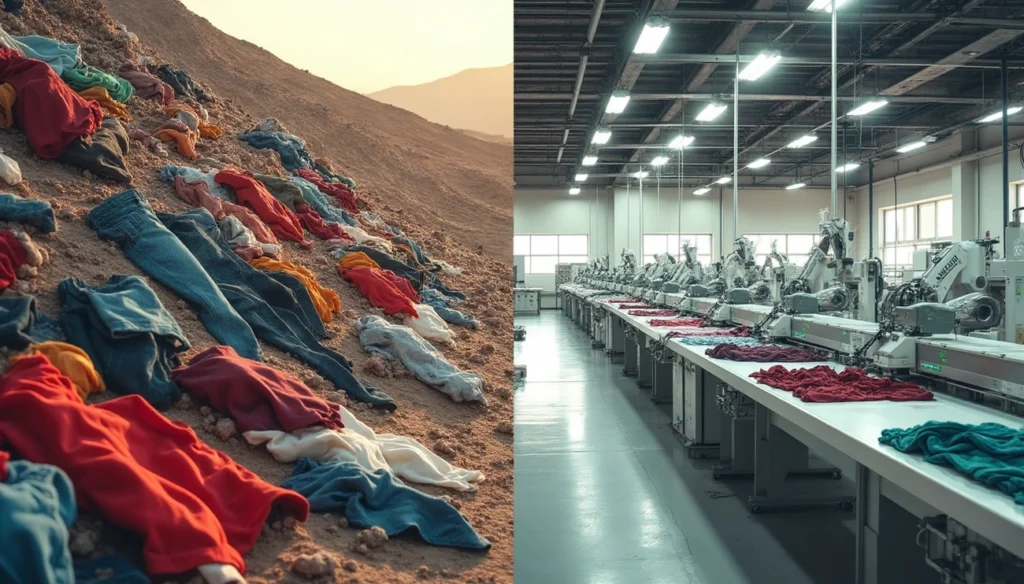
Fashion and AI are reshaping an industry responsible for 10% of global greenhouse gas emissions, outpacing aviation and shipping combined. When you consider that 30% of clothing is never sold and ends up in landfills, alongside the billion tons of CO₂ emitted annually, it’s clear why sustainable transformation is urgently needed.
However, the sustainable fashion market is projected to grow by 2030, and this growth is largely fueled by AI, which can reduce fabric waste by up to 60% while simultaneously cutting operational costs by 25%. Furthermore, sustainable fashion and AI are creating a powerful partnership that addresses both environmental concerns and consumer demands.
Throughout this article, you’ll discover how fashion design and AI are coming together to create affordable, sustainable clothing. Specifically, we’ll explore how generative AI in fashion is revolutionizing design processes, how fast fashion and AI are at a crossroads, and why 2025 marks a turning point for making ethical clothing accessible to everyone.
The sustainable fashion movement faces a persistent dilemma that affects both brands and consumers. On one hand, there’s growing awareness about the environmental and social impacts of clothing production. On the other hand, making sustainable choices remains financially challenging for many.
The economics of fast fashion rely on cutting corners—exploiting cheap labor in less-regulated environments while using low-quality materials that quickly fall apart. This business model has conditioned consumers to expect unrealistically low prices, with one-third of young people unwilling to pay more for sustainable garments.
Indeed, the cost difference between sustainable and conventional fashion can reach nearly 50%. This price gap exists for several legitimate reasons:
Most consumers remain unaware of what goes into making clothing ethically—factory workers might earn but a few cents from a typical shirt costing 15 euros.
Artificial intelligence offers promising solutions to this affordability-sustainability conflict. Through advanced data analysis, AI can help fashion companies maintain ethical standards while keeping costs manageable:
According to McKinsey, AI in apparel and luxury could unlock an additional £218.39 billion in operating profit over the next five years. Most importantly, these efficiencies make sustainable fashion more accessible to average consumers—allowing ethics and economics to finally align.
Modern design studios are increasingly turning to data rather than hunches to create successful collections. Unlike traditional methods, AI-powered design provides a scientific approach to fashion creation that’s both cost-effective and environmentally responsible.
Accurate trend forecasting empowers designers to produce items consumers genuinely desire. Advanced AI systems analyze millions of social media posts, runway images, and sales data to identify emerging style patterns with over 90% accuracy. This precision eliminates guesswork and allows brands to detect trends across specific regions, age groups, and subcultures.
The consequences of inaccurate predictions are severe in an industry where 40% of fashion products worldwide aren’t sold at full price and 25% aren’t sold at all. By integrating consumer insights with creative expertise, AI helps designers align products with market demands, significantly reducing waste while maintaining profitability.
Perhaps the most dramatic cost reduction comes from virtual sampling. Traditional prototyping requires multiple physical samples for each design iteration—consuming materials, dyes, and shipping resources. Digital alternatives are transforming this process:
These technologies not only decrease expenses but also shorten development timelines, allowing brands to respond faster to market trends without compromising quality or sustainability.
Creative AI tools are revolutionizing how designers conceptualize collections. Generative systems can transform text descriptions or rough sketches into detailed designs within seconds, producing dozens of variations in minutes rather than days. This capability enables designers to explore more creative options while focusing their expertise on refinement and curation.
Additionally, platforms like CLO 3D and Optitex streamline virtual prototyping with unprecedented precision, allowing designers to create realistic garment simulations that dramatically reduce the need for physical samples.

The complex global fashion supply chain represents a 1.19 trillion industry where AI is now transforming operations from factory floor to retail door.
AI analytics platforms now aggregate vast amounts of supply chain data in real-time, creating unprecedented visibility into operations previously hidden across fragmented global networks. Businesses implementing AI-driven resource planning systems have managed to reduce operation and administrative costs. Moreover, companies using industry-specific AI solutions saw an additional revenue increase over generic systems.
AI-powered route optimization algorithms analyze traffic conditions, weather patterns, and delivery schedules to minimize transportation expenses. These systems can reduce fuel usage through shorter travel distances and less idle time. At the same time, AI-driven defect detection systems can identify fabric flaws with over 98% accuracy, preventing downstream waste. In warehousing, AI directs automated systems that dramatically improve efficiency while cutting energy consumption.
Consequently, AI analyzes supplier sustainability credentials, certifications, and performance metrics to identify partners aligned with both ethical and economic goals. For instance, Farfetch employs AI to assess supplier sustainability credentials, while companies like Adidas use AI to optimize inventory and production, thereby reducing waste and unsold stock.
Beyond economic benefits, AI technology brings ethical advances to the fashion world. As companies recognize that sustainable style must work for everyone, artificial intelligence is becoming a powerful ally in creating a more inclusive and circular industry.
AI algorithms now scan fashion photography and advertising materials to identify underrepresented groups or stereotypical portrayals. These systems flag problematic content before publication, ensuring marketing campaigns reflect diverse communities. Similarly, advanced neural networks analyze design elements that might unconsciously favor certain body types or cultural backgrounds, prompting designers to create truly universal collections.
Meanwhile, computer vision systems can now identify fabric composition with remarkable accuracy, separating blended materials that were previously impossible to recycle. Additionally, blockchain-powered platforms track garments throughout their lifecycle, facilitating resale and rental markets. These technologies essentially create digital “material passports” that follow clothing from production through multiple owners, supporting repair services and eventual recycling.
Given increasing government oversight, brands are turning to AI compliance tools that monitor production against evolving standards. These systems primarily track water usage, chemical consumption, and labor practices—automatically generating documentation for regulatory bodies. Furthermore, predictive analytics help companies anticipate upcoming legislation, allowing proactive adaptation rather than costly retrofitting.
Fashion and AI are coming together to change sustainable clothing forever. AI technology makes ethical fashion choices available to regular shoppers, not just those who can afford luxury items.
AI also alters how clothes are made and sold. Smart design choices based on data slow down excess production. Virtual samples cut costs, and on top of that, improved supply chains save on operating costs. These savings go straight to customers without cutting corners on ethical standards.
Understanding the importance of AI in sustainability practices and the issues it can solve makes it a game changer for those who want to embed smart programs in their business operations. For example, in the fashion industry, AI helps reduce fabric waste and determine the best shipping routes. Brands can spot bias in their marketing and reach customers of all backgrounds. Now meeting tough environmental rules becomes easier.
Sustainable fashion and AI powered solutions can support a much wider audience. Brands work better and take fewer risks, while shoppers have access to quality clothes at fair prices. What seemed impossible before—affordable and sustainable fashion—is now within reach.
The future looks bright as human creativity teams up with fashion and AI capabilities. You can now buy clothes that match your values and your budget.
